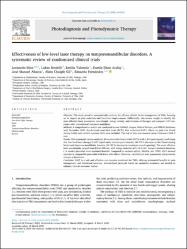| dc.contributor.author | Díaz, Leonardo | |
| dc.contributor.author | Restelli, Lukas | |
| dc.contributor.author | Valencia, Emilia | |
| dc.contributor.author | Atalay, Damla İlhan | |
| dc.contributor.author | Abarca, José Manuel | |
| dc.contributor.author | Gil, Alain Chalple | |
| dc.contributor.author | Fernández, Eduardo | |
| dc.date.accessioned | 2025-04-02T07:43:22Z | |
| dc.date.available | 2025-04-02T07:43:22Z | |
| dc.date.issued | 2025 | en_US |
| dc.identifier.citation | Díaz L, Restelli L, Valencia E, Atalay DI, Abarca JM, Gil AC, Fernández E. Effectiveness of low-level laser therapy on temporomandibular disorders. A systematic review of randomized clinical trials. Photodiagnosis Photodyn Ther. 2025 Mar 15;53:104558 | en_US |
| dc.identifier.issn | 1572-1000 | |
| dc.identifier.uri | https://pubmed.ncbi.nlm.nih.gov/40096874/ | |
| dc.identifier.uri | https://www.sciencedirect.com/science/article/pii/S1572100025000870 | |
| dc.identifier.uri | https://hdl.handle.net/20.500.12780/1071 | |
| dc.description.abstract | Objective: This study aimed to systematically evaluate the efficacy of LLLT in the management of TMD, focusing
on its impact on pain reduction and functional improvement. Additionally, this review sought to identify the
most effective laser parameters (wavelength, energy density, and duration of therapy) and compare LLLT out comes with conventional treatment modalities.
Methods: A comprehensive search was conducted across PubMed, Scopus, Web of Science, and EBSCO databases
until December 2024. Randomized controlled trials (RCTs) that evaluated LLLT’s effects on pain (via Visual
Analog Scale) and vertical aperture (VA) were included. The risk of bias was assessed using Cochrane’s RoB 2
tool.
Results: This systematic review analyzed 44 randomized clinical trials (RCTs) with 1,816 participants, confirming
that low-level laser therapy (LLLT) significantly reduces pain intensity (60–70 % decrease on the Visual Analog
Scale) and improves mandibular function (10–20 % increase in maximum mouth opening). The most effective
laser wavelengths ranged from 810 to 940 nm, with energy densities of 3–12 J/cm². Longer treatment durations
(>4 weeks) provided more sustained benefits. Compared to occlusal splints, NSAIDs, and TENS, LLLT showed
superior or comparable pain relief with fewer side effects. However, variability in laser parameters and protocols
remains a limitation.
Conclusion: LLLT is a safe and effective non-invasive treatment for TMD, offering substantial benefits in pain
management and functional recovery. Standardized protocols based on optimized dosimetry are needed to
enhance clinical outcomes further. | en_US |
| dc.language.iso | eng | en_US |
| dc.publisher | Elsevier | en_US |
| dc.relation.isversionof | 10.1016/j.pdpdt.2025.104558 | en_US |
| dc.rights | info:eu-repo/semantics/openAccess | en_US |
| dc.subject | Photobiomodulation | en_US |
| dc.subject | Low level light therapy | en_US |
| dc.subject | Laser | en_US |
| dc.subject | TMJ | en_US |
| dc.subject | Temporomandibular disorders | en_US |
| dc.subject | Clinical trials | en_US |
| dc.subject | Review | en_US |
| dc.title | Effectiveness of low-level laser therapy on temporomandibular disorders. A systematic review of randomized clinical trials | en_US |
| dc.type | article | en_US |
| dc.contributor.department | İstanbul Kent Üniversitesi, Fakülteler, Diş Hekimliği Fakültesi, Klinik Bilimler Bölümü | en_US |
| dc.contributor.authorID | 0000-0002-6042-0643 | en_US |
| dc.contributor.institutionauthor | Atalay, Damla İlhan | |
| dc.identifier.volume | 53 | en_US |
| dc.relation.journal | Photodiagnosis and Photodynamic Therapy | en_US |
| dc.relation.publicationcategory | Makale - Uluslararası Hakemli Dergi - Kurum Öğretim Elemanı | en_US |


















